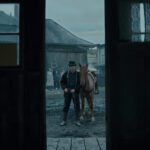Fremont, CA, USA – Tuesday, February 27, 2024 – Blackmagic Design today announced that Colorist Mark Kueper of Picture Shop graded season one and two of the MGM+ series “Billy the Kid” using DaVinci Resolve Studio editing, color grading, visual effects (VFX) and audio post production software.
An epic romantic adventure series based on the life of famous American outlaw Billy the Kid, the show follows the title character from his humble Irish roots, to his early days as a cowboy and gunslinger in the American frontier, to his pivotal role in the Lincoln County War and beyond. Season one’s pilot was shot by Cinematographer Paul Sarossy and directed by Otto Bathurst. The series’ cinematography was by Paul Sarossy, Ronald Paul Richard, Sylvaine Dufaux and Craig Powell.
Involved early in the process of pre production, Kueper was excited about working on a show shot in Calgary, in the Canadian province of Alberta. “I jumped at the chance to grade images of such a beautiful place,” said Kueper.
With neither the director nor the cinematographer having experience shooting a western before, they insisted on doing some test photography in and around the shooting location, located in the town of Drumheller. “We were able to do look development and set the visual language for the show,” continued Kueper. “We talked about ways to make the landscape more foreboding. Everywhere you point the camera in Calgary looks great, and springtime outside of Calgary is very lush and green. We needed to make it feel more arid and dustier, like New Mexico. We could see desaturating the foliage and resisting postcard skies would help set the mood.”
To achieve a unique look for the show, Sarossy and Bathurst chose to shoot film with vintage Petzval lenses. “The character of these lenses was a big part of the look, but there are actually only two focal lengths available for this lens,” added Kueper. “The lenses have specific aberrations, and vignetting and focus fall off at the edges of frame depending on what stop you are at.”
For wider shots and second unit, Sarossy needed to bring in other lenses, which meant matching the Petzval style in post. Kueper noted, “We had to emulate those lenses in DaVinci Resolve by defocusing edges with tilt shift blur and aperture diffraction.”
While Kueper created an interior and exterior shooting LUT for production, he found he could also add to the filmic look after shooting. “I used FilmConvert Nitrate plugin because it has a luma mode that compresses the low blacks but also lifts them to give ambience like print does,” continued Kueper. “It was something we could have incorporated into the shooting LUT, but I didn’t want to bake it in since it would be too aggressive for night scenes. We also used it to add grain to the show as well.”
New tools in DaVinci Resolve Studio also helped speed up the grade. “During the grading of season one we used match move for sky replacement. Now, in season two we can use the sky replace tool, which is quicker and better,” Kueper explained.
Other tools in DaVinci Resolve Studio have helped Kueper add or enhance practical effects or manage on set challenges. “Fast noise has been really helpful to add smoke or fog for continuity. There were several instances that we needed to add dust in scenes where horses are running through town or add gun smoke ambience to match shots that were missing it. Flicker addition worked nicely to get lanterns to have a more natural feel, as some LED lanterns have a rhythmic flicker that doesn’t look natural,” he noted.
While Kueper does start with a set node tree in his grading process, his focus is on moving past the heavy lifting and focusing on the artistic side of the scenes. “Things like action scenes take the most amount of time,” said Kueper. “You may work on a scene for an hour and think, ‘hey I did a lot of work here,’ then find out you only did a few minutes of show. When you finally get that scene to a good place it’s a good idea to move on and look at it again later with fresh eyes so you don’t get lost in small details. I usually get some ideas to sweeten shots that I struggled with to make the scene better. This is every colorist’s challenge. For me, when I grade a scene that really speaks to me because I think it looks great, it is rewarding. When you are seeing how you are enhancing a shot instead of fixing it, it drives the creativity up. We as colorists are only as good as the images in front of us. I guess what I am saying is that the reward doesn’t come from the struggle, it comes from the art.”
“Billy the Kid” is now streaming on MGM+.
Press Photography
Product photos of DaVinci Resolve Studio and all other Blackmagic Design products are available at www.blackmagicdesign.com/media/images
About Blackmagic Design
Blackmagic Design creates the world’s highest quality video editing products, digital film cameras, color correctors, video converters, video monitoring, routers, live production switchers, disk recorders, waveform monitors and real time film scanners for the feature film, post production and television broadcast industries. Blackmagic Design’s DeckLink capture cards launched a revolution in quality and affordability in post production, while the company’s Emmy™ award winning DaVinci color correction products have dominated the television and film industry since 1984. Blackmagic Design continues ground breaking innovations including 6G-SDI and 12G-SDI products and stereoscopic 3D and Ultra HD workflows. Founded by world leading post production editors and engineers, Blackmagic Design has offices in the USA, UK, Japan, Singapore and Australia. For more information, please go to www.blackmagicdesign.com


1 Comment
us3en7